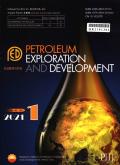Characteristics, genetic mechanism and hydrocarbon accumulation of inverted structures in the Doseo Basin, Chad
IF 8
Q1 ENERGY & FUELS
引用次数: 0
Abstract
Based on two-dimensional/three-dimensional seismic and logging data, combined with the analysis of low-temperature thermochronology data, the unconformity surface characteristics and the patterns and dynamic mechanisms of inverted structures in the Doseo Basin in the Central and West African rift systems are systematically analyzed. Seismic profiles reveal two key inversion unconformable surfaces in the basin, i.e. the T5 interface within the Upper Cretaceous and the T4 interface at the top of the Cretaceous, which control the development of inverted structures in the basin. Four types of inverted structures, i.e. fault-associated, thrust, fold, and back-shaped negative flower, are identified. Spatially, they form six inverted structural belts trending in NE-NEE direction. The thermal history simulation of apatite fission track reveals two rapid cooling events in the late Late Cretaceous (85–80 Ma, cooling by 15 °C) and the Eocene–Oligocene (30–40 Ma, cooling by 35 °C), corresponding respectively to the formation periods of the T5 and T4 interface. The dynamics analysis of structural inversion indicates that the structural inversion in the Late Cretaceous was controlled by the subduction and long-range compression within the Tethys Ocean in the north of African Plate, while the structural inversion in the Eocene–Oligocene was drived by the stress transmission from the African–Eurasian collision. The two events were all controlled by the continuous tectonic regulation of the intracratonic basin by the evolution of the Tethys tectonic domain. The two periods of structural inversion enhanced the efficiency of oil and gas migration by controlling the types of traps (anticline and fault-related traps) and fault activation, precisely matching the hydrocarbon generation peaks of the Lower Cretaceous source rocks in the Late Cretaceous and Eocene, thereby controlling the formation of large-scale oil and gas reservoirs in the Doseo Basin. This geological insight provides a critical basis for the theoretical research on the evolution and hydrocarbon accumulation of inverted structures in discrete strike-slip rift systems.
乍得Doseo盆地逆构造特征、成因机制及油气成藏
基于二维/三维地震和测井资料,结合低温热年代学资料分析,系统分析了中非和西非断陷系多西盆地不整合面特征、逆构造模式和动力机制。地震剖面揭示了盆地内两个关键的反演不整合面,即上白垩统T5界面和白垩统顶部T4界面,它们控制着盆地内逆构造的发育。确定了断层伴生、逆冲、褶皱和背向负花四种逆构造类型。空间上形成6条北东—北东东方向的逆构造带。磷灰石裂变径迹的热历史模拟揭示了晚白垩世晚期(85 ~ 80 Ma,降温15℃)和始新世—渐新世(30 ~ 40 Ma,降温35℃)两个快速降温事件,分别对应了T5和T4界面的形成时期。构造反演动力学分析表明,晚白垩世构造反演受非洲板块北部特提斯洋内俯冲和远程挤压作用的控制,始新世-渐新世构造反演受非洲-欧亚碰撞应力传递的驱动。这两次事件均受特提斯构造域演化对克拉通内盆地的连续构造调节所控制。两次构造反转通过控制圈闭类型(背斜圈闭和断层相关圈闭)和断层活化,精确匹配了晚白垩世和始新世下白垩统烃源岩的生烃高峰,从而控制了道西盆地大规模油气藏的形成,提高了油气运移效率。这一地质认识为离散走滑裂谷系统中逆构造演化和油气成藏的理论研究提供了重要依据。
本文章由计算机程序翻译,如有差异,请以英文原文为准。
求助全文
约1分钟内获得全文
求助全文

 求助内容:
求助内容: 应助结果提醒方式:
应助结果提醒方式:


